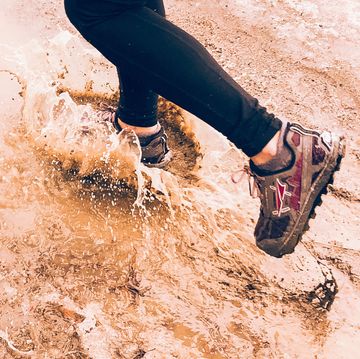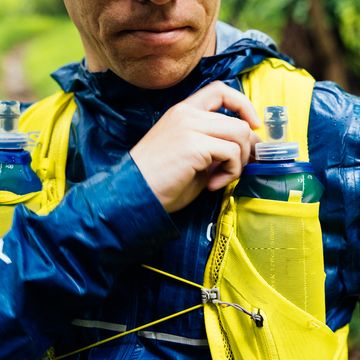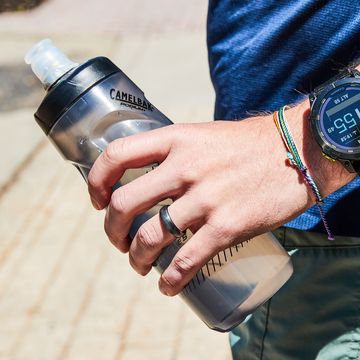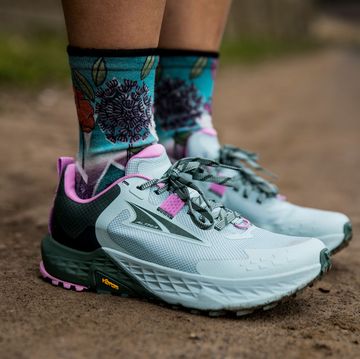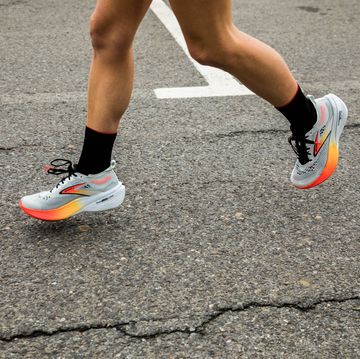In 1997, just two months after moving from the grass and dirt of Kenya to the paved roads of the United States, Stephen Ondieki, 28, started experiencing severe pain in both feet. He thought he just needed to adjust to running on hard surfaces, but an exam revealed the real culprit. His feet excessively pronated (collapsed inward) when he ran, and as a result his knees rotated inward. This double whammy put too much stress on his lower limbs, resulting in five stress fractures in both feet. The remedy? It wasn't surgery, rehab, or an introduction to the swim coach. All Ondieki needed was an orthotic, a shoe insert that corrects biomechanic inefficiencies. "It corrected the problem once and for all," says Ondieki, who finished second in the 2000 Division I-AA Cross-Country Championships and won the 2003 Hispaniola Half-Marathon in the Dominican Republic wearing custom-made orthotics.
Available over the counter or prescribed by podiatrists, orthotics properly align your feet to avoid and treat injuries. About 25 percent of people have a normal running pattern--their foot pronates just enough to absorb shock. The rest of the running population overpronates or underpronates, meaning their foot turns too much or not enough at heel-strike. Orthotics can correct these imbalances by adjusting the angles at which the foot strikes the ground. And that's just the beginning. Orthotics are often considered the cure-all for just about any kind of lower-body, running-related injury, says sports podiatrist Richard Braver, D.P.M. They are used to treat plantar fasciitis (heel pain), chronic blisters, shinsplints, and leg-length discrepancies. "Orthotics can prevent and cure a problem by reducing and eliminating the stress that caused it," Braver says.
You'd think with all the technology that goes into making today's running shoes, runners wouldn't need additional support. But Ray Fredericksen, president of Sports Biomechanics Inc. and Runner's World technical editor, says companies skimp on the sock liner (the thin insole that comes with the shoe). "Sock liners are designed to break down and conform to the foot to enhance the fit," he says. "They're not designed to add extra cushion or act as an orthotic or a stabilizer." That's why so many runners are replacing them with over-the-counter or prescription alternatives. In fact, about $375 million was spent on over-the-counter orthotics in 2003, up 14 percent from the previous year.
But orthotics, especially prescription ones, should be one of your last options, Braver says. Think of them like any other prescription. If you have a sore throat, you'd try cough drops before penicillin. Same goes here. Custom orthotics cost between $375 and $450, and only about half of all insurance companies cover the cost. They aren't an overnight solution either. A podiatrist makes a plaster cast of your foot, and then a lab creates the insole from the cast. It can be about a month before you get them, and then when you do, they're still not race-ready. You need to break them in for one to two weeks, and you could feel some discomfort until you get accustomed to them. If you're experiencing some kind of lower-body or foot pain, Braver recommends this course of action:
Get Fitted
Problems can occur when you're in the wrong shoes. People with low arches as well as heavier runners need more stable, motion-control shoes, and those with high arches need more cushioning. Visit a specialty running store to make sure you're wearing what's right for you. The runnersworld.com Shoe-Finder can also help you find a pair.
Alternate Shoes
"Most runners get injured because they run the same pace on the same surface on the same shoe, day in and day out," says Fredericksen. By alternating the shoes you're running in, the slight modification will give you relief from a high-stress area. If you like one particular brand and style, you can just rotate a slightly worn shoe with a new pair, Fredericksen says.
See a Pro
Orthotics are often the solution for structural deficiencies. But if your pain is caused by tight or weak muscles, Braver says, a physical therapist or massage therapist could solve the problem--and make orthotics unnecessary. See a sports podiatrist for a proper diagnosis. ("Ask The Doc," right, will help you find one.)
Go Shopping
You can pick up a pair of Dr. Scholl's for less than $10 at a drugstore, but specialty-running stores can help you choose the best insole for your foot and shoe. Insoles from these shops cost about $20 to $40 and last about a year. Before you buy, press on the arch of the insert, Braver says. If it collapses, it's not supportive enough. Also, don't buy half-insoles that just go under your heel. "You push off the ball of your foot, and that's when your foot pronates and collapses inward," Braver says. "So the insole needs to cover this area." If you find an insole that helps--but not 100 percent--take them to a podiatrist, who can customize them. It's cheaper ($75 to $100) than a prescription orthotic, and may work just as well, Braver says. In fact, a study published in the July issue of the American Orthopaedic Foot and Ankle Society's journal found no significant difference in the incidence of foot problems between users of custom orthotics and those who wore over-the-counter devices.
Step it up
If all else fails, custom orthotics are probably the way to go. Not only are they molded specifically for your foot, but the materials chosen to make the orthotics reflect your particular running needs. Custom-made orthotics should last at least five years, and podiatrists can also refurbish them every couple of years to prolong their lives.
If you think you might be a candidate for orthotics, visit the American Academy of Podiatric Sports Medicine's Web site at aapsm.org to find a sports podiatrist in your area. Ask potential doctors these questions before making an appointment. If you hear too many "no" answers, run to another.
Do you run?
Some podiatrists make a hasty prescription for foot pain: Don't run. "That's a bad podiatrist in my opinion," Ray Fredericksen says. "You want someone who understands your passion and will keep your running healthy."
Do you need to see my running shoes?
If a podiatrist doesn't tell you to bring in your shoes, he won't be inspecting wear pattern--which is a key diagnostic tool to determine the movement pattern of your foot, and figuring out what shoe and orthotic will work for you.
Do you customize over-the-counter orthotics?
They may cure the problem at 25 percent of the cost of prescriptions.
Do you refurbish prescription orthotics?
Some podiatrists will keep your cast, and can make modifications to existing orthotics before they break down. Refurbishing--usually done every two or three years--costs about $150 to $200, but you get all new materials while keeping the original shell, for half the cost of a new one.
Do you keep the cast?
If they hold it indefinitely, it'll cost you less next time you need to have new orthotics made. If they toss the cast immediately, ask if you can keep it--it'll save you money if you can provide it next time. --T.S
Orthotics For Your Shoes
More runners are spending big bucks on orthotics. Should they be in your shoes, too?
by Ted Spiker

Watch Next

Advertisement - Continue Reading Below

Best Shoe Deodorizers for Keeping Your Feet Fresh

The Best Running Sunglasses of 2024

The Best Wireless Earbuds Memorial Day Sales 2024

The Best Memorial Day Treadmill Sales 2024
Advertisement - Continue Reading Below
Advertisement - Continue Reading Below


